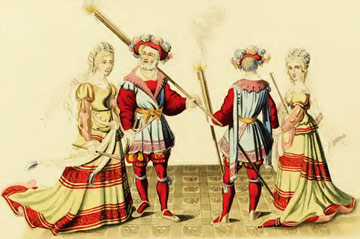Renaissance Clothing
Renaissance clothing was considered by some critics less tasteful than the dress of previous centuries. In England, the costume of the 16th century was seen as rich, expensive, but somehow stiff and ungraceful. Well, that remains to be seen.

German Renaissance Costumes
At the beginning of the 16th century, a marked difference occurred in costume development. One important innovation was the hose fitting close to the leg. The upper portion from the knee, or the middle of the thighs, was slashed, puffed, and embroidered, so it was made distinct from the lower. The upper portion was named hose, and the lower stocking. The large wide sleeves were attached to the shoulders of the vest of both sexes, and were separate and distinct articles, sometimes of a different colour.
Renaissance Clothing in England
During the reign of Henry VIII, the costume was influenced by German-Swiss and Flemish fashion. It was completely different from the characteristic dress of the reign of Henry VII, and its character will be maintained under Edward VI.
Men’s Renaissance clothing under Henry VIII is characterized by the broad-toed shoes, the white shirt embroidered in black silk, the padded shoulders, and the flat cap.
The German-Swiss Renaissance costume was the creation so well captured in the works of Albrecht Dürer and Holbein. In parallel, the English fashion itself transformed the most extravagant models of Henry VII reign into the “blistered” clothes of the time of Henry VIII.
It appears that the “blistered” clothes had their origin in the victory of the Swiss against the Duke of Burgundy at Nantes, in 1477. It is said that the soldiers cut and tore up his silk tents, banners, basically all the material they could find. They made clothes of these odd pieces, and the clothes were so torn and ragged that their shirts puffed out of every hole. The clothes of the victorious army caused everybody to start imitating them, and the courtiers proclaimed the “blistering” style as the new fashion.
Women Renaissance clothing during the reign of Henry VIII is defined first by the changes in the head dress, mainly the hood.The slight changes in the Renaissance dress under Edward VI and then Mary I are important because they prelude the important ones taking place under Elizabeth I.
Queen Elizabeth's era, the time of great discoveries and adventurers like Drake or Raleigh, is also the epoch of the well known Elizabethan costume.
It was a period when extravagance went above certain limits and in 1579, the Queen had to give her "commandment" to the lord chancellor and privy-council to curb excesses in dress, such as “excessive long clokes, being in common sight monstrous”.
“Neither also shoulde any person use or weare such great and excessive ruffes, in or about the uppermost part of their neckes” All persons shoulde, in modest and semely sort, leave off such fonde, disguised, and monstrous manner of attyring themselves, as both was unsupportable for charges, and undecent to be worne."Gossip voices argued that the sole purpose of the commandment was to prevent any rivalry in clothing extravagance when compared with the Queen's dress.
Truth is, women Renaissance clothing was characterized by a superabundance of refinement, and was accompanied by the painting of ladies' faces which now became usual.